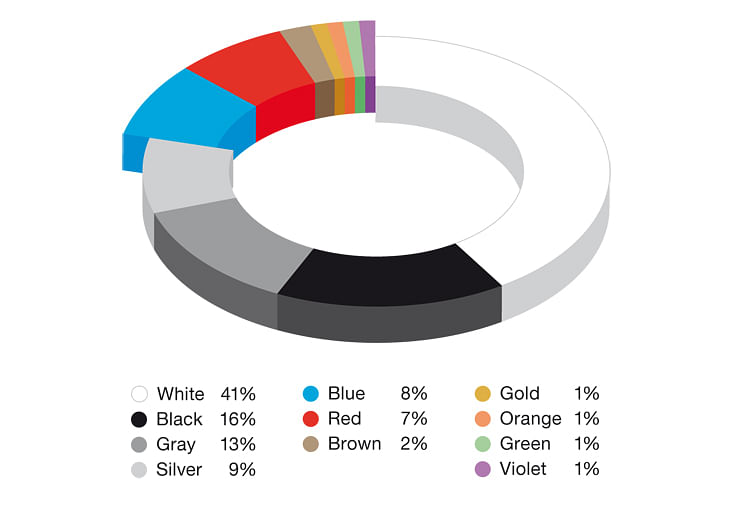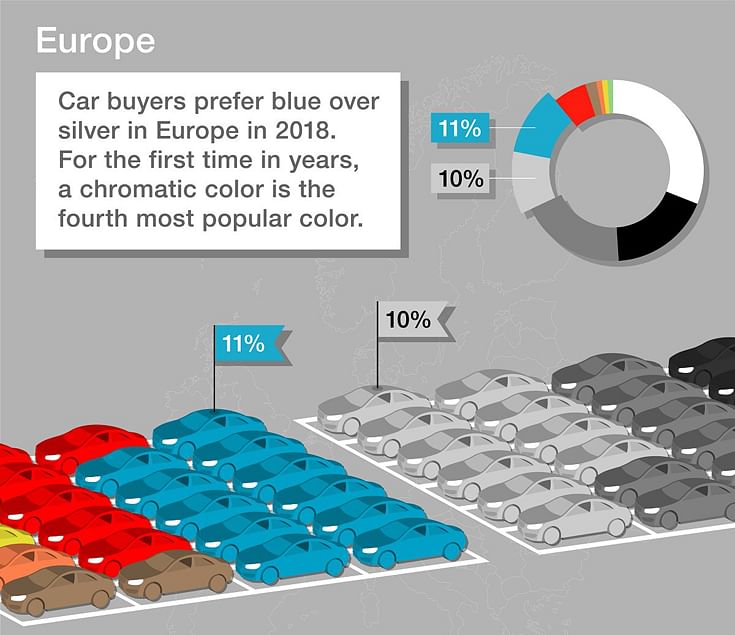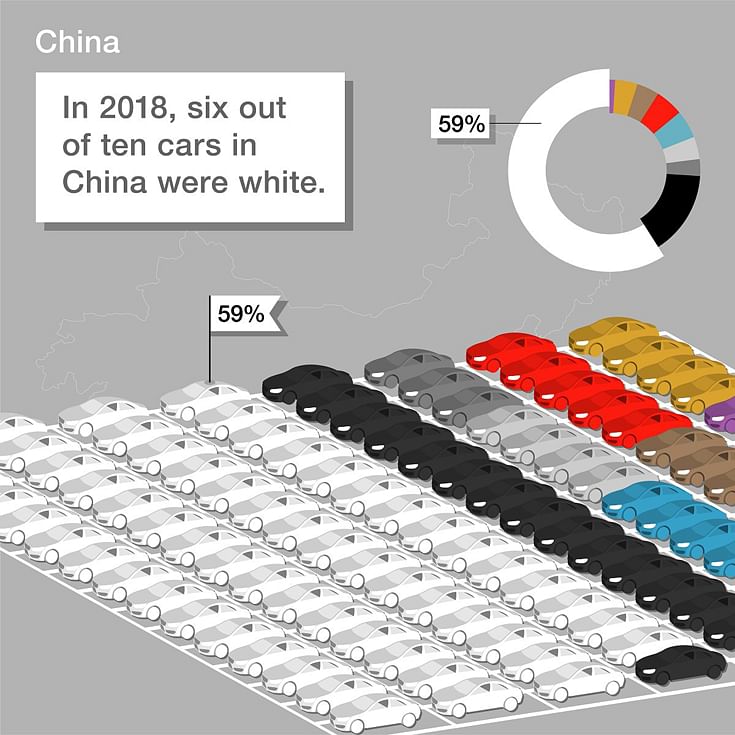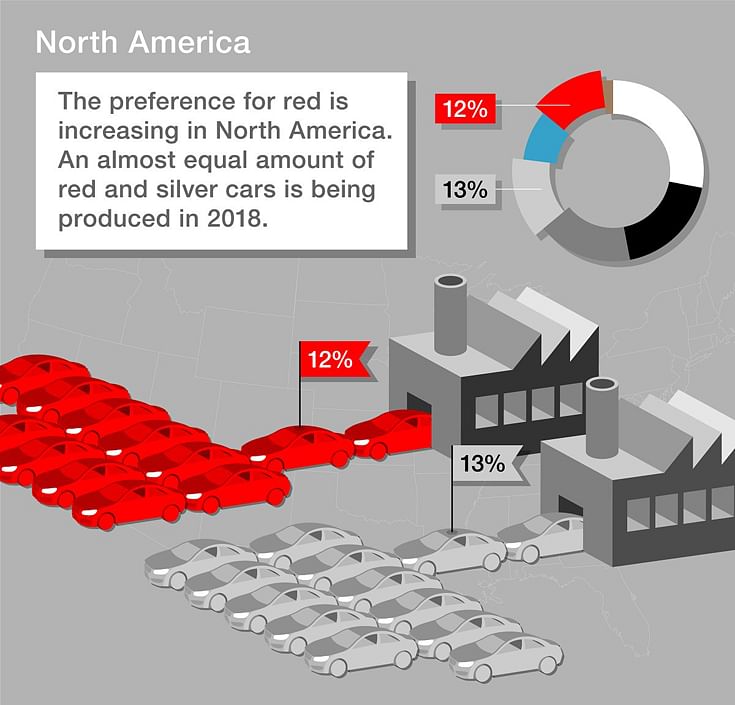White remains top global colour for cars in 2018
As per the latest ‘BASF Color Report for Automotive OEM Coatings’, white has triumphed over other colours – in India and globally. While blue is the most popular chromatic colour worldwide, effect coatings create more diverse choices and raise popularity of achromatic colours.
White has won again. As per the latest ‘BASF Color Report for Automotive OEM Coatings’, white colour has triumphed over other colours – in India and globally.
 Each year, BASF’s Coatings division provides a global analysis of the colour distribution in the 2018 automotive market. The achromatic colours – white, black, grey and silver – still dominate the roads. They cover almost 80 percent of cars produced worldwide. The fact though is that white clearly is the most popular colour. More than every fourth car in North America and nearly every third vehicle in Europe is painted white, while in Asia Pacific it is more than every second car. And in India, 43 per cent of car buyers chose this colour tone in 2018.
Each year, BASF’s Coatings division provides a global analysis of the colour distribution in the 2018 automotive market. The achromatic colours – white, black, grey and silver – still dominate the roads. They cover almost 80 percent of cars produced worldwide. The fact though is that white clearly is the most popular colour. More than every fourth car in North America and nearly every third vehicle in Europe is painted white, while in Asia Pacific it is more than every second car. And in India, 43 per cent of car buyers chose this colour tone in 2018.
Globally, silver’s popularity decreased slightly in comparison to the previous year. Among the diverse range of colour shades, blue is the most popular, followed by red. These chromatic colours tend to be more popular within the smaller vehicle segments, such as compact and subcompact cars. The overall amount of chromatic hues drops off significantly in the larger segments. Here, there was a considerable increase in black and white compared to the previous year.

Effects create new colour variations in Europe
Nearly every fifth car in Europe is painted gray, which replaced black as the second most popular colour. Buyers can choose from more than 110 variations ranging from light grey to dark metallic anthracites. Blue offers even more options. Approximately 140 shades make blue as the region’s most diverse colour space. With a share of 11 percent, it overtook silver in 2018, becoming the fourth most desired colour in Europe.
A metallic or pearlescent effect also significantly contributes to the unique look of a car. In 2018, two-thirds of all vehicles were finished with an effect coating. The larger the car, the more likely it was painted with an effect. Dark colours such as black and grey are mostly formulated to have a metallic effect, whereby lighter colors are primarily solid shades. “The landscape of automotive coatings effects evolves continuously and is shaped by new and inspiring ideas,” said Mark Gutjahr, head of Automotive Color Design Europe at BASF’s Coatings division.

White most popular in APAC but chromatic colours gaining
White is more popular in Asia Pacific than in any other region. Around 53 percent of all new cars are white. The colour’s popularity grew significantly in comparison to the previous year. Among chromatic colours, red is still the most popular choice. Blue, however, is closing the gap. An interesting observation is that brown remains especially popular with SUVs but has shown signs of slowing down, indicating that its importance in this segment may have passed.
Car buyers in Asia Pacific are increasingly connecting their colour preferences to their attitudes and lifestyles. For example, metallic and sparkling blacks have risen in demand across several body segments. Even in subcompact cars, silvers and greys with dazzling effects are becoming more common.

This can be seen in the Chinese market, where a broader palette of colours has emerged. “The diversity of chromatic colours is evident, with red, blue, yellow, brown and gold hues appearing in almost every segment. Chinese consumers readily display their coloristic tastes more so than in the past”, said Chiharu Matsuhara, head of Automotive Color Design Asia Pacific.
Indian car buyers vote for white
In the Indian market, which saw total sales of 3,394,756 passenger vehicles in CY2018, white is the most-preferred choice for consumers with 43 percent of them opting for the tone in 2018. The other two most popular PV colours last year were grey and silver with each finding preferences of 15 percent of buyers. Red with 9 percent was followed by blue at 7 percent, while black had just 3 percent buyers.
“Small cars which are pearl white in colour are popular among Indian consumers. Customers in the warm climate of India may prefer white because white cars do not heat up so quickly,” said BASF Head of Design (Asia-Pacific) Chiharu Matsuhara, in a PTI report. She added, “Another reason might be the luxurious image of this colour, as suggested by our trend observations.”
White also rules in the sports utility vehicle (SUV) segment, the report said with 41 percent new buyers going in for the colour, followed by grey 15 percent, silver 14 percent, red 12 percent and blue 7 percent.
In the entry-level sub-compact segment, 42 percent of buyers went for white colour, 17 per cent with grey and 16 percent for silver. Red was the other popular colour in the segment with 12 percent. In the basic compact segment, white was also the most popular colour with 35 per cent of buyers opting for it, followed by grey and silver with 17 percent each, red 9 per cent and blue 8 per cent, among other colours.
In the compact (premium) segment also, the BASF colour report said white was the most-popular colour with 46 per cent of consumers going for it, followed by silver at 21 per cent and grey at 17 per cent. Interestingly, only 1 per cent preferred black colour.
However, in the mid-sized segment, black was the second-most popular colour with 18 per cent behind white which had preference of 40 per cent buyers. The other popular colours in the segment were blue at 16 per cent and silver at 13 percent and brown 5 percent, among others.
 Achromatic colours in N America offer a look into the future
Achromatic colours in N America offer a look into the future
In 2018, the achromatics remained the most popular automotive colours for North America, accounting for roughly 75 percent of market production. Among the achromatic colors, white maintains its leading position. Besides the achromatic shades, consumers continued to demonstrate a growing affinity for red, specifically within the pickup and sports car segments. The diverse blue colour space remained nearly the same compared to the prior year.
Over the last 10 years, Crossover Utility Vehicles (CUVs) have emerged as a dominant vehicle segment in North America. White is the most popular colour in this segment, followed by black and gray. Blues and reds are almost equally desired by car buyers. “In coating large surfaces for the CUV segment, the industry looks to bring a suitable visual expression of the vehicle’s perceived use and link it to the brand image,” said Paul Czornij, head of Automotive Color Design for BASF North America.
Predicting future preferred colours
BASF’s Coatings division has an excellent understanding of what is trending in materials and colours, and uses this to predict which colours will play a key role in the future automotive market.
Every year, the Coatings division’s designers create Automotive Color Trends, an innovative collection of 65 new colours based on extensive research and in-depth analysis of global trends and cultural shifts that will influence automotive colors three to five years into the future.
Integrated into its colour design innovations, BASF offers a range of sustainable coatings solutions for the automotive industry. Among these are coatings that enable a shortened application and curing process, which can reduce CO2 emissions by up to 20 percent, waterborne basecoats that meet strict global regulations to minimise the volatile organic compound (VOC) content, and coatings with a temperature management functionality whereby the car surface does not heat up as much as conventional coatings, minimizing the heat build-up in interiors.
RELATED ARTICLES
Autoliv Plans JV for Advanced Safety Electronics With China’s HSAE
The new joint venture, which is to be located strategically near Shanghai and close to several existing Autoliv sites in...
JLR to Restart Production Over a Month After September Hacking
Manufacturing operations at the Tata Group-owned British luxury car and SUV manufacturer were shut down following a cybe...
BYD UK Sales Jump 880% in September to 11,271 units
Sales record sets the UK apart as the largest international market for BYD outside of China for the first time. The Seal...






 By Autocar Professional Bureau
By Autocar Professional Bureau
 16 Jan 2019
16 Jan 2019
 11081 Views
11081 Views





 Ajit Dalvi
Ajit Dalvi




